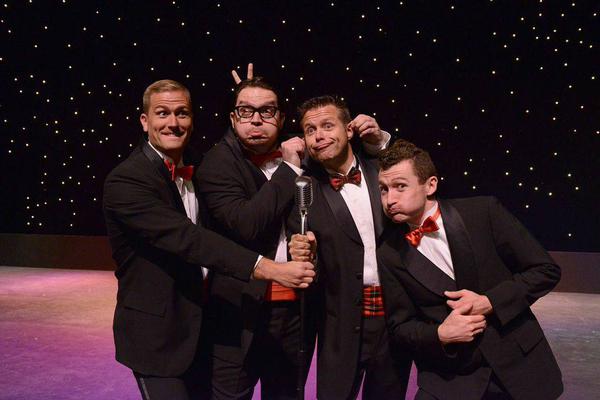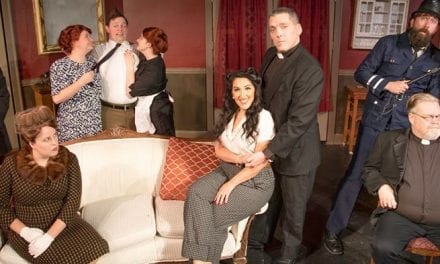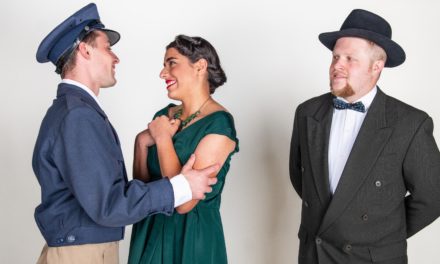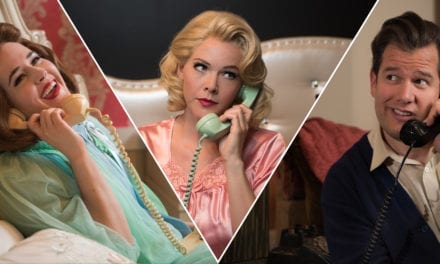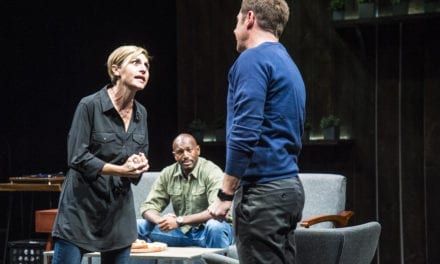SOUTH SALT LAKE — Frankie, Smudge, Sparky, and Jinx comprise a singing group called “The Plaids.” They don’t seem to be anything special, just a couple of nice guys; they’ve had no epic romances, fame, or financial success. But on the stage of The Grand Theater, over the course of 90 minutes, it becomes clear that these characters truly have everything they need: they have their music, and they have each other—even in the afterlife.
The musical Forever Plaid was written by Stuart Ross, who basically put together a musical revue of songs from the 1950’s and 1960’s, knitted together with dialogue and humor. It is surprisingly satisfying, despite its humble description. Each of the actors presented a distinct personality and each had his moment to shine throughout the production. Mark Daniels played the youthful Frankie as an unstoppable optimist, and Sparky (Jonathan Baker) was like that odd kid who says random things, but you love him anyway. B. J. Whimpey’s Smudge seemed to be the most recognizable personality: very open and genuine. That deep bass voice of his was warm and powerful in “Sixteen Tons.” Nick Morris became my favorite of The Plaids, with his shy smiles and beautiful croon. “Cry” and “No, Not Much” were two highlights of the show for me.
Three more performers round out this cast: the pianist, percussionist, and bass player. These musicians (Kevin Mathie, Dave Evanoff, and Adam Overacker) stayed mostly in the shadows, but they played with skill and effortlessness, creating an appropriate lounge setting, which I loved. I had no idea that I would so enjoy that era of music, but these musicians made the Forever Plaid score smooth and comforting, like a lullaby.
Ross’s script was a nice peek back into the past, with references to early 1960’s celebrities, a 3 minute summary of The Ed Sullivan show, wide-eyed innocent innuendos, and (shrug) a bit of naïve racism—“She take me money and run Venezuela.” The Ed Sullivan bit was quite a circus, with plates spinning and magician-type tricks; there were also impersonations and a clever moment of ventriloquism.
I had very few problems with this production. Besides a tissue joke that made me gag, my main issue was with the dialogue in the first part of the show. The characters alternated between speaking to the audience and talking among themselves, back and forth; but their tone/volume never changed. So, rather than feeling like I was listening in on their conversation, it felt false, corny, and awkward. I was glad that the opening dialogue didn’t last long.
The structure of the set was simple; but vibrant colors, a starry sky, and a curtain of shining tinsel backed the actors. Always complimented by colorful lighting, each new song came with a visual “wow” factor. The tinsel background was especially fascinating because the light could change its appearance so dramatically, and patterns could be projected onto it as well. Scenic designer Halee Rasmussen and lighting designer Josh Martin perfectly complimented the tone of this play. Old fashioned microphones and long-handled plungers were a nice touch. Amanda Reiser’s costumes designs were bright and crisp. Jinx looked so great with his finger-wave hairstyle, and Smudge wore old-fashioned glasses. The Plaids were dressed in tuxedo pants, pleated white shirts, plaid cummerbunds, and “dinner jackets.” They looked very dapper, so when they later put on grass hats and sombreros, the contrast made me smirk.
The venue was very fitting for the show, being backstage at The Grand. It felt intimate enough for the familiarity the cast projects. Director Jim Christian provided a fun variety of staging and choreography. I particularly liked the dancing during “Crazy Bout You Baby.” The pacing of the show felt very natural and the environment inviting.
So much of Forever Plaid invites the audience to be part of the play. During the song “Moments To Remember,” a woman from the audience was pulled up to dance with The Plaids, which added comedy to what could have been a dull song. Another bit of viewer interaction came at the intro to “Heart and Soul.” They started playing those familiar notes so many pianists have plunked, and asked who of us knew how to play that song. Along with about half of the crowd, I sort of weakly raised my hand from the fourth row. And then, completely shocked, I saw Frankie standing beside me, hand outstretched, asking me to join them onstage. “I don’t know if I remember it,” I pleaded, but somehow he led me through it. Truly those few minutes were an absolute blur for me; but apparently it was a hilarious scene, according to my husband.
Frankie has a monologue before the final number, describing the song in musical terms, naming specific chords and notes, which many people won’t understand because of the detailed description of musical theory. But he delivered it in a such a emotional way that I doubt anyone could miss his meaning. I got teary. It was sweet to see the bond between these guys, even as fictional characters; they are a reminder of friendship and of passion for art. Who needs fame and fortune when you’re surrounded by love, right?

